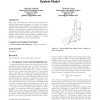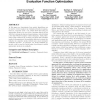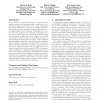GECCO
2008
Springer
14 years 19 days ago
2008
Springer
The fitness landscape of a problem is the relation between the solution candidates and their reproduction probability. In order to understand optimization problems, it is essenti...
GECCO
2008
Springer
14 years 19 days ago
2008
Springer
The fully informed particle swarm optimization algorithm (FIPS) is very sensitive to changes in the population topology. The velocity update rule used in FIPS considers all the ne...
GECCO
2008
Springer
14 years 19 days ago
2008
Springer
Given the importance of optimization and informatics which are the two broad fields of research, we present an instance of Optinformatics which denotes the specialization of info...
GECCO
2008
Springer
14 years 19 days ago
2008
Springer
Genetic algorithms (GAs) used in complex optimization domains usually need to perform a large number of fitness function evaluations in order to get near-optimal solutions. In rea...
GECCO
2008
Springer
14 years 19 days ago
2008
Springer
This paper demonstrates the effectiveness of genetic algorithms in training stable behavior in a model of the spinoneuromuscular system (SNMS). In particular, we test the stabili...
GECCO
2008
Springer
14 years 19 days ago
2008
Springer
In this work a branch prediction system which utilizes evolutionary techniques is introduced. It allows the predictor to adapt to the executed code and thus to improve its perform...
GECCO
2008
Springer
14 years 19 days ago
2008
Springer
In this paper we demonstrate how genetic algorithms can be used to reverse engineer an evaluation function’s parameters for computer chess. Our results show that using an approp...
GECCO
2008
Springer
14 years 19 days ago
2008
Springer
Recent advances in XCS technology have shown that selfadaptive mutation can be highly useful to speed-up the evolutionary progress in XCS. Moreover, recent publications have shown...
GECCO
2008
Springer
14 years 19 days ago
2008
Springer
Hereditary Repulsion (HR) is a selection method coupled with a fitness constraint that substantially improves the performance and consistency of evolutionary algorithms. This als...
GECCO
2008
Springer
14 years 19 days ago
2008
Springer
We study the minimum s-t-cut problem in graphs with costs on the edges in the context of evolutionary algorithms. Minimum cut problems belong to the class of basic network optimiz...





